Foraging in the wintertime can sometimes be difficult, but there are always conifer needles! Any recipe that uses conifer needles really intrigues me, so I thought it was time for me to make something with them myself. These festive foraged conifer needle shortbread cookies are perfect for the holidays! They’re crisp and crumbly, the perfect recipe for a real food cookie swap, homemade food gift, or a sweet treat for your family.
Edible Conifer Needles for Cookies
I often visit the central California coast where redwood trees abound, so they seemed like a natural choice for this recipe.
I am always in awe of redwood trees, and they make me extremely happy to be around. They definitely are a special tree, and these redwood needle shortbread cookies is the perfect way to enjoy their awesomeness!
Of course, you don’t have to use redwood needles for this recipe. Most foraged conifer needles such as pine, spruce, fir, and hemlock (the tree, not the hemlock the toxic plant) are edible, and any of them would work well in this recipe.
The only one you want to avoid is the Yew tree, as it is highly toxic.
Please see my post on how to identify conifer trees to learn more.
Rosemary would also be a lovely substitution for the conifer needles. In fact, I have a recipe for meyer lemon and rosemary shortbread cookies that are just as delicious!
Related: What to Forage in Winter: 30+ Edible and Medicinal Plants and Fungi
Conifer Needle Shortbread Cookie Recipe
To make these foraged conifer needle shortbread cookies, begin by finely mincing the conifer needles. It may be easiest to pulse them a few times in a food processor or blender.
Then zest the orange.
Cream together the butter and sugar, then add the egg yolk, orange juice and orange zest, and stir to combine. Then add the flour, arrowroot, minced conifer needles, cinnamon, cloves, and salt.
Gently stir everything together until the dough barely holds together. It will seem a bit floury, but that’s ok.
Take the dough out of the bowl and use your hands to form it into a flat disk. Wrap it up in parchment paper and refrigerate for at least 30 minutes or until firm.
You can store the dough for several days in the fridge, or for several weeks in the freezer if need be.
When ready to cook, preheat the oven to 300°F. Roll out the dough onto a floured board to about 1/4 inch thick, and use cookie cutters to cut into desired shapes.
You can alternatively shape the dough into a log before refrigerating it, and then slice the cookies into rounds.
Put the cut cookies onto a parchment (or silicone mat) lined cookie sheet about an inch or so apart.
If you want to get fancy and have a pretty garnish on your cookies, gently press a redwood (or other conifer) tip into the top of the cookie.
Bake for 25-30 minutes, or until just beginning to turn golden brown on the edges.
The centers will still be just barely soft. These were done right at 25 minutes, so keep a close watch on them after that.
Remove from the oven and let them cool for a bit on the cookie sheet before transferring to a cooling rack.
Can I just say how happy I am with how these cookies turned out?
They are pretty (not usually my forte), as well as extremely tasty. The orange and spices really add to the wonderful piney flavor of the redwood needles.
These redwood needle shortbread cookies make a perfect holiday treat. Great for entertaining or for a cookie swap. Even better that they are made with foraged ingredients!
Here is some more conifer cookie inspiration:
- Magical Douglas Fir Shortbread Cookies from Nitty Gritty Life
- Pine Needle Sugar Cookies from Learning and Yearning
- Foraged Evergreen Shortbread Cookies from The Kitchn
I hope this inspires you to make some redwood or other conifer cookies. I’m thinking spruce tips might be nice, that’s what I might try next time!
More Foraged Conifer Needle Recipes
There are many other great ideas for using conifer needles!
- 30+ Conifer Needle Recipes
- Pine Needle Cough Syrup
- Fir Needle Forest Chai
- Spruce Beer
- Conifer Infused Vodka
- Homemade Infused Gin
Conifer Needle Shortbread Cookies
Equipment
Ingredients
- 14 Tbsp (2 sticks minus 2 Tbsp) unsalted butter softened
- 3/4 cup sugar
- 1 egg yolk
- 2 Tbsp orange juice
- 1 Tbsp orange zest a microplane is the best tool for this, hands down!
- 1 1/2 cups all purpose flour
- 1/2 cup arrowroot powder or cornstarch
- 1/4 cup conifer needles any edible conifer needles such as pine, spruce, fir, hemlock, or redwood needles will work
- 1 tsp ground cinnamon
- 1/2 tsp ground cloves
- pinch salt
Instructions
- Finely mince the conifer needles. It may be easiest to pulse them a few times in a food processor or blender.
- Cream together the butter and sugar, then add the egg yolk, orange juice and orange zest, and stir to combine. Then add the flour, arrowroot, minced conifer needles, cinnamon, cloves, and salt.
- Gently stir everything together until the dough barely holds together. It will seem a bit floury, but that’s ok. Take the dough out of the bowl and use your hands to form it into a flat disk.
- Wrap it up in parchment paper and refrigerate for at least 30 minutes or until firm. You can store the dough for several days in the fridge, or for several weeks in the freezer if need be.
- When ready to cook, preheat the oven to 300°F.
- Roll out the dough onto a floured board to about 1/4 inch thick, and use cookie cutters to cut into desired shapes. You can alternatively shape the dough into a log before refrigerating it, and then slice the cookies into rounds.
- Put the cut cookies onto a parchment (or silicone mat) lined cookie sheet about an inch or so apart. If you want to get fancy and have a pretty garnish on your cookies, gently press a redwood (or other conifer) tip into the top of the cookie.
- Bake for 25-30 minutes, or until just beginning to turn golden brown on the edges. The centers will still be just barely soft. These were done right at 25 minutes, so keep a close watch on them after that. Remove from the oven and let them cool for a bit on the cookie sheet before transferring to a cooling rack.
Notes
- Any edible conifer needle works in this recipe, such as pine, spruce, fir, hemlock, or redwood.
- Do not use the Yew family of trees, as they are highly toxic.
- For more information see my post on identifying conifer trees.





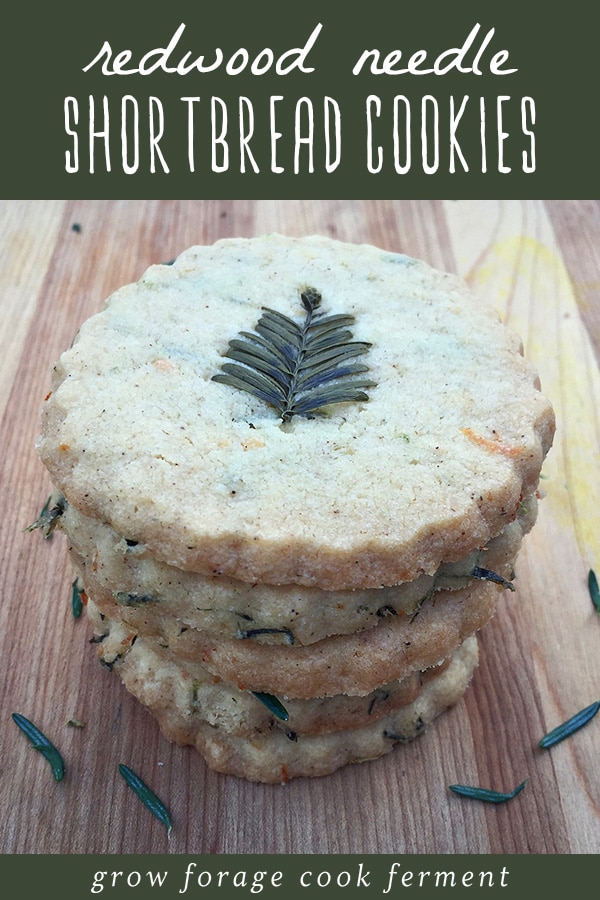

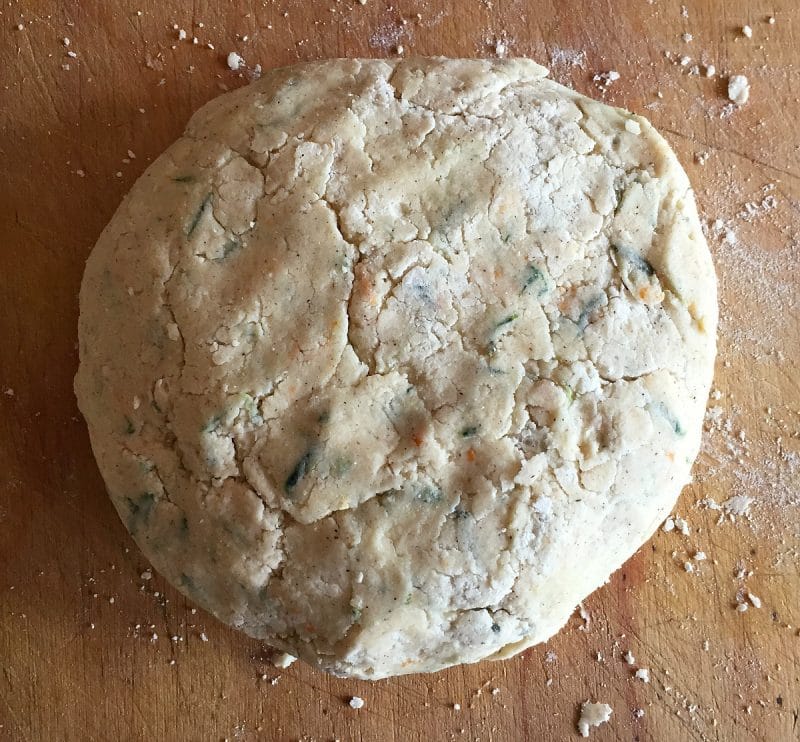
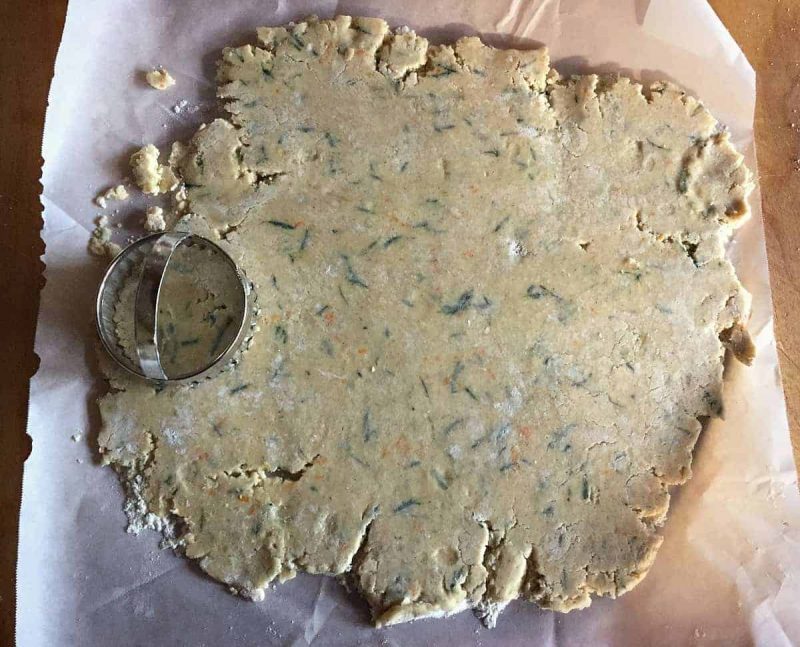

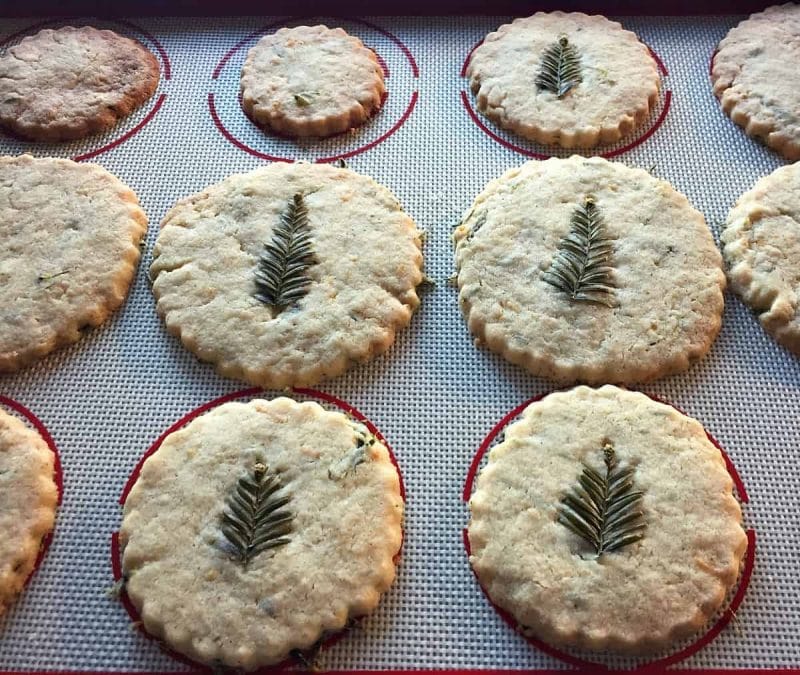
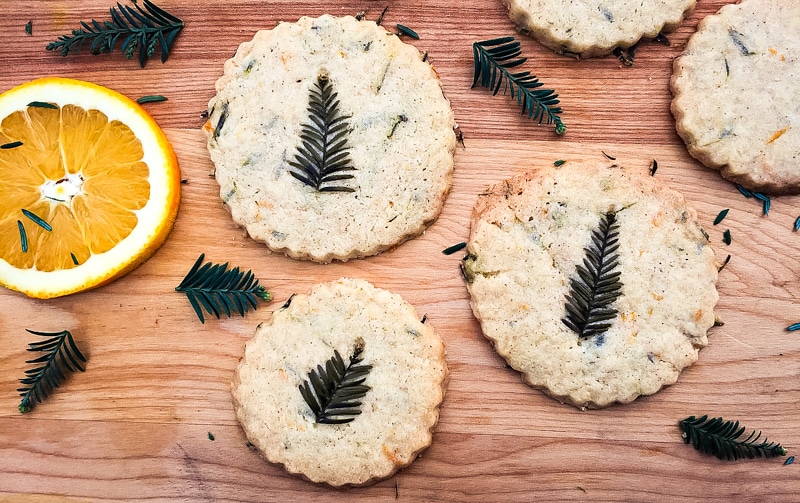
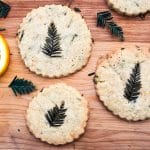

Make sure you use 1/4 cup od pine needles, not 1/4 cyp of minced pine needles. Also make sure you finely mince the needles as chewing a whole needle is not palatable.
Years ago friends of mine where horrified to learn that I daily snip of the new tips of our Hemlock tree in the spring and eat them. As you have done here, I educated them on the difference between the poisonous flowering plant and the tree, both with the same name.
Awesome! More people need to be informed of the differences between them!
They just look so darn cute! I had to add this to my Pinterest boards and some other SM outlets! Love this idea, thanks for sharing!
Hemlock! All Hemlock species contain a narcotic poison. If you don’t make your guests seriously ill or end up killing them if they over consume, they will end up with narcotic intoxication.
Hemlock the evergreen conifer tree (Tsuga sp.) is not poisonous at all. Hemlock the tall flowering plant (Conium maculatum) is very poisonous. They are two completely different species with the same common name, unfortunately. I thought it was clear that I meant the evergreen conifer, but maybe I’ll edit the post to make it very clear so as not to cause any confusion :)
interesting! I never thought of adding them to cookies. I recently had a beer that was brewed with redwood needles instead of hops, but there was no distinct flavor to me. Have a good visit, Santa Cruz local here!